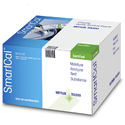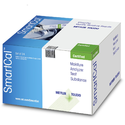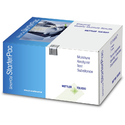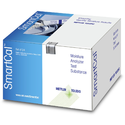- Quick and easy performance test in just 10 minutes
- Documented performance with measurement reports to monitor moisture analyzer performance over time
- Testing at point of use for trusted moisture results
- Done just like a normal moisture measurement
- Certified version available to satisfy regulatory requirements
- SmartCal StarterPac to get you up and running right away
SmartCal Test Substance
Fast performance check for moisture analyzers
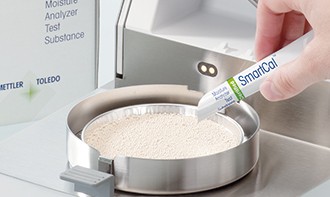
Quick and Easy Performance Test
Simply select the integrated SmartCal method on the instrument, distribute the contents of the test sachet evenly over the sample pan and start the measurement. After 10 minutes, you know if your instrument's performance is satisfactory.
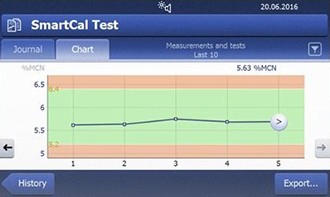
Documented Instrument Performance
SmartCal measurement reports make it easy to monitor and interpret your instrument's performance over time. Results can be stored directly in the instrument or manually entered into our free validated Excel® report sheet.
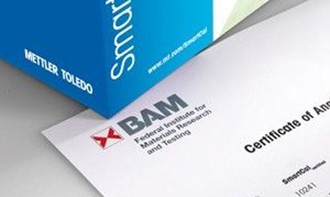
Certified for Regulated Industries
Choose SmartCal if you require a test substance that is certified by an independent institute. The cSmartCal certificate satisfies the strictest regulatory requirements.
Products and Specs
Documentation
Product Information
Manuals
SOPs
Applications & Know-How
SmartCal FAQ
Frequently Asked Question about Moisture Analyzer testing substance
1. What is SmartCal?
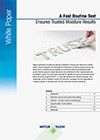 SmartCal is a highly temperature sensitive granular material, with a defined moisture content. It is an ideal test substance for moisture analyzers because a specific amount of moisture is released depending on the applied drying temperature: the higher the drying temperature, the higher the measured moisture content. SmartCal enables the verification of the performance of a moisture analyzer with a simple 10 minute test.
SmartCal is a highly temperature sensitive granular material, with a defined moisture content. It is an ideal test substance for moisture analyzers because a specific amount of moisture is released depending on the applied drying temperature: the higher the drying temperature, the higher the measured moisture content. SmartCal enables the verification of the performance of a moisture analyzer with a simple 10 minute test.
Download our white paper "A fast routine test ensures trusted moisture results"
2. Why should I test my moisture analyzer?
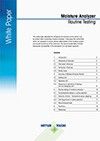 A moisture analyzer consists of a heating device and an integrated balance. A fault in either component, or external influences such as the ambient temperature or drafts, can potentially cause errors in results. To verify that results are accurate and conform to quality regulations if necessary, it is crucial to be sure that both components − the balance and the heating source − are functioning correctly.
A moisture analyzer consists of a heating device and an integrated balance. A fault in either component, or external influences such as the ambient temperature or drafts, can potentially cause errors in results. To verify that results are accurate and conform to quality regulations if necessary, it is crucial to be sure that both components − the balance and the heating source − are functioning correctly.
Download our white paper "Moisture analyzer routine testing"
3. Why should I test my moisture analyzer with SmartCal?
A key benefit of the SmartCal test method is that it monitors the overall instrument performance, i.e. the heating and the weighing unit together, rather than testing each element separately. Regular testing with SmartCal between service and calibration intervals is a fast, easy and cost-effective way to ensure that all results produced by the moisture analyzer are accurate and quality requirements are fulfilled.
4. What are the benefits of using the SmartCal moisture analyzer test substance?
Using SmartCal you get:
- A clear indication if the instrument is working correctly
- An easy instrument test procedure which can be performed by non-skilled operators
- Fast results – the test only takes 10 minutes
- A documented trend of the instrument's performance
5. What is the benefit of SmartCal compared to other moisture analyzer test substances, such as sodium tartrate?
Test substances like sodium tartrate or sodium chloride also have a defined moisture content but are not temperature sensitive. This means that regardless of the applied temperature, the same amount of moisture is released. Consequently, these substances are not suitable to test the heating unit of a moisture analyzer as they can only verify the weighing system (see illustration below). In contrast, SmartCal, as previously described, is a highly temperature dependent test substance which enables the accuracy of the drying temperature (selected vs. actual) to be confirmed, making it suitable for testing the performance of the weighing and heating components of a moisture analyzer.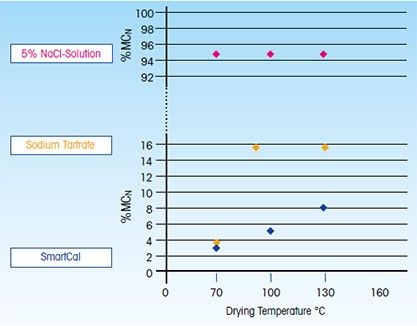
The ammount of moisture released by sodium tartare or 5% sodium chloride
solution does not vary between 100 - 130 C, making these substances unsuitable
for verification of the heating component of a moisture analyzer.
6. What is the outcome of a SmartCal test and how do I need to interpret results?
During the measurement the weight-loss in time is recorded and at the end the result is expressed in moisture content – just as any normal measurement. For each of the predefined temperatures (70°C, 100°C, 130°C, 160°C) METTLER TOLEDO provides control limits. The result of the moisture must be within the corresponding control limits if the test was performed with a current METTLER TOLEDO moisture analyzer. For older METTLER TOLEDO moisture analyzers and third party moisture analyzers, the result must be within the instrument specific control limits.
Download the SmartCal User Guide
7. How do I perform a SmartCal test?
To perform a SmartCal test, simply select the built-in SmartCal method on your moisture analyzer (for models HB43-S, HE73, HC103, HS153 or HX204 ) and follow the instructions on the screen.
If you are using any other moisture analyzer:
I. Program the moisture analyzer with the following measurement parameters
- Drying method: standard
- Drying temperature: 100°C
- Switch off criterion: time - 10 minutes
- Display: %MC
II. Making the measurement with SmartCal
- Place a sample dish in the instrument and tare
- Remove a SmartCal stick from the blister pack, tear it open, and distribute the entire contents evenly over the sample pan
- Start the measurement immediately
- Read the end result after 10 minutes and normalize moisture reading to ambient conditions to obtain normalized moisture content (%MCN).
Watch the video to see how SmartCal works.
8. What are the SmartCal control limits and where are they applicable?
The SmartCal control limits for current METTLER TOLEDO moisture analyzers have been established taking into account all current product families (HE53/73, HC103, HS153, and HX204). All these moisture analyzers are manufactured with the aid of SmartCal and are therefore guaranteed to lie within the specified control limits. Older MT instruments (including HB43-S and HR73/83) were not produced with SmartCal and the specified control limits are not applicable.
9. Why do SmartCal results have to be normalized?
The SmartCal test result must always be normalized (%MCN) by applying a correction factor as the SmartCal specifications are based on measurement at standard conditions (20 °C and 50 % relative humidity (RH)). The correction factor is very easily determined using the ambient conditions (temperature, RH) during the test measurement. The normalized result can be calculated automatically by the latest halogen moisture analyzers (e.g. Mettler Toledo HX/HS/HC models), by either manually entering the actual temperature and RH or by connecting an RHT sensor that records the conditions automatically. Alternatively, the normalized result can be calculated automatically using the Excel® management report tool.
10. How should I interpret the SmartCal test results?
If the moisture analyzer is working correctly, the test result, determined at a specific drying temperature, should vary around a mean value and lie within the control limits (as shown below), although not necessarily in the middle of the specified range.
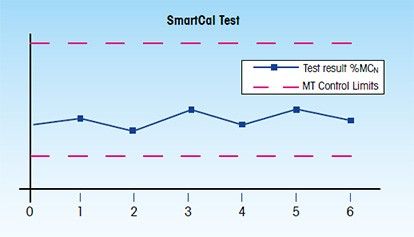
SmartCal test results lie within the control limits over time. Each test result
indicated by a blue square. Control limits (tolerances) indicated by pink lines.
11. Why don't the SmartCal results have to be in the middle of the control limits?
The SmartCal control limits take into account all current MT moisture analyzer families and their variations. A single moisture analyzer therefore may lie anywhere within those limits. Accordingly, it is important that a single instrument does not show wide scatterings, jumps or trends over time. A wide scattering of measurements is typically caused by unstable test conditions, such as air drafts, handling or using a warm instrument. Several consecutive test measurements which show a trend in the same direction could potentially be caused by incorrect normalization, contamination on protective glass or reflector, a defective or contaminated temperature sensor, or a defective instrument.
12. What to do in case of deviations?
If a measurement is outside the specified range, the measurement should be repeated with a new sachet of test substance, after ensuring that any possible causes like a contaminated protective glass or mishandling have been considered and addressed. If the result is still outside the limits adjust the instrument using a temperature and weight calibration kit. Additional support is available from METTLER TOLEDO Service.
13. Which types of SmartCal products are available?
All SmartCal offerings (Sampler, StarterPac, Test sachets) are available in two versions – cSmartCal (certified version) and SmartCal.
14. What is the difference between cSmartCal and SmartCal?
The differences between the two versions are the type of certification and tolerance bands. cSmartCal ('certified SmartCal') is tested for absolute moisture content by the independent German Federal Institute for Materials Testing and Research (BAM) and comes with a certificate of analysis providing full traceability fulfilling the requirements of highly-regulated industries. In contrast, standard SmartCal comes with a production certificate from MT confirming that it is within production tolerances.
15. Where can I find the certification for SmartCal?
All SmartCal certificates can be downloaded here: SmartCal Certificate Search. Type in the SmartCal Lot number which is on the SmartCal stick (without leading zeros, e.g. 144) and the corresponding PDF of the certificate is provided.
16. How long can I store SmartCal?
The shelf-life is 36 months after the production date. The expiry date of each SmartCal lot is printed on all the corresponding packaging and on the certificate.
17. How do I get started with SmartCal?
Every customer should start using SmartCal with the StarterPac, it includes all the necessary tools and documentation to properly work with SmartCal.
18. How often should I use SmartCal?
Typical test frequency is once per month. However, test frequency should be risk-based and is therefore dependent on your process.
19. Does SmartCal eliminate the need for temperature and balance tests?
No it does not! Maintaining the accuracy of an instrument and reducing the risk of being out of specification requires testing by a qualified service provider and the user. The following approach is recommended for a risk-based performance monitoring of a moisture analyzer:
- Calibration (service engineer)
- SmartCal test (user and service engineer)
- Temperature calibration (user and service engineer)
- Metrological testing (user and service engineer)
For further information on routine testing, refer to the white paper: Moisture Analyzer Routine Testing .
20. Which testing temperature should be chosen?
To use built-in SmartCal tests select the testing temperature closest to your most frequently used method, you can choose 70°C, 100°C, 130°C or 160°C. Control limits for the current portfolio have been established for these four temperatures. However, SmartCal can also be used at any temperature within the temperature range of the instrument. In this case, the user must specify their own limits for the chosen temperature.
21. Is my instrument performing correctly if the result lies within the control limits?
For the first measurement this is true. However, the control limits also include instrument to instrument variation of the complete current portfolio and are therefore not sufficient to judge a single instrument. In addition, you need to carefully judge/analyze your SmartCal results. The SmartCal values should show good repeatability, results should not jump around and there should be neither a clear upward nor downward trend of the SmartCal values.
Please refer to the SmartCal User Guide, (Chapter 4):
22. Can SmartCal be used for non-MT moisture analyzers?
Yes! SmartCal can be used for any moisture analyzer. However, the control limits provided by MT are only applicable to the current portfolio (HX204, HS153, HC103, HE73, and HE53).
